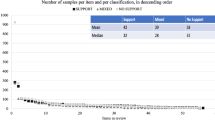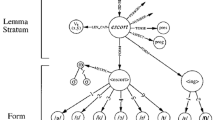Abstract
Does the language we speak shape the way we think? The present research concentrated on the impact of grammatical gender on cognition and examined the persistence of the grammatical gender effect by (a) concentrating on German, a three-gendered language, for which previous results have been inconsistent, (b) statistically controlling for common alternative explanations, (c) employing three tasks that differed in how closely they are associated with grammatical gender, and (d) using Tamil, a nongendered language, as a baseline for comparison. We found a substantial grammatical gender effect for two commonly used tasks, even when alternative explanations were statistically controlled for. However, there was basically no effect for a task that was only very loosely connected to grammatical gender (similarity rating of word pairs). In contrast to previous studies that found effects of the German and Spanish grammatical gender in English (a nongendered language), our study did not produce such effects for Tamil, again after controlling for alternative explanations, which can be taken as additional evidence for the existence of a purely linguistic grammatical gender effect. These results indicate that general grammatical gender effects exist but that the size of these effects may be limited and their range restricted.
Similar content being viewed by others
References
Barner, D., Inagaki, S., & Li, P. (2009). Language, thought, and real nouns. Cognition, 111, 329–344.
Bellugi, U., Bihrle, A., & Corina, D. (1991). Linguistic and spatial development: Dissociations between cognitive domains. In N. Krasnegor, D. Rumbaugh, R. Schielfelbusch, & M. Studdert-Kennedy (Eds.), Biological determinants of language development (pp. 368–398). Hillsdale, NJ: Erlbaum.
Boroditsky, L. (2001). Does language shape thought? Mandarin and English speakers’ conceptions of time. Cognitive Psychology, 43, 1–22.
Boroditsky, L. (2003). Linguistic relativity. In L. Nadel (Ed.), Encyclopedia of cognitive science (pp. 917–921). London: MacMillan Press.
Boroditsky, L. (2009). How does our language shape the way we think? In M. Brockmman (Ed.), What’s next? Dispatches on the future of science (pp. 116–129). New York: Vintage Press.
Boroditsky, L., & Schmidt, L. A. (2000). Sex, syntax, and semantics. Proceedings of the Cognitive Science Society, 22, 42–47.
Boroditsky, L., Schmidt, L. A., & Phillips, W. (2003). Sex, syntax, and semantics. In D. Gentner & S. Goldin-Medow (Eds.), Language in mind: Advances in the study of language and thought (pp. 61–79). Cambridge, MA: MIT Press.
Bowerman, M. (1996). The origins of children’s spatial semantic categories: Cognitive versus linguistic determinants. In J. Gumperz & S. Levinson (Eds.), Rethinking linguistic relativity (pp. 145–176). Cambridge: Cambridge University Press.
Brown, R., & Lenneberg, E. (1954). A study in language and cognition. Journal of Abnormal and Social Psychology, 49, 454–462.
Brysbaert, M., Fias, W., & Marie-Pascale Noe, M.-P. (1998). The Whorfian hypothesis and numerical cognition: Is ‘twenty-four’ processed in the same way as ‘four-and-twenty’? Cognition, 66, 51–77.
Carroll, J. B., & Casagrande, J. B. (1958). The function of language classifications in behavior. In E. E. Maccoby, T. M. Newcomb, & E. L. Hartley (Eds.), Readings in social psychology (pp. 18–31). New York: Henry Holt.
Chen, J.-Y. (2007). Do Chinese and English speakers think about time differently? Failure of replicating Boroditsky (2001). Cognition, 104, 427–436.
Cohen, J. (1992). A power primer. Psychological Bulletin, 112, 155–159.
Cohen, J., Cohen, P., West, S. G., & Aiken, L. S. (2003). Applied multiple regression/correlation analysis for the behavioral sciences (3rd ed.). Mahwah: Erlbaum.
Dehaene, S., Spelke, E., Pinel, P., Stanescu, R., & Tsivkin, S. (1999). Sources of mathematical thinking: Behavioral and brain-imaging evidence. Science, 284, 970–974.
Deutscher, G. (2010). Through the language glass: How words colour your world. London: William Heinemann.
Elman, J. (1990). Finding structure in time. Cognitive Science, 14, 179–212.
Ervin, S. M. (1962). The connotations of gender. Word, 18, 249–261.
Fodor, J. (1983). The modularity of mind. Cambridge, MA: MIT Press.
Furth, H. (1966). Thinking without language. New York: Free Press.
Gelman, R., & Gallistel, R. (1978). The child’s understanding of number. Cambridge, MA: Harvard University Press.
Gentner, G., & Imai, M. (1997). A cross-linguistic study of early word meaning: Universal ontology and linguistic influence. Cognition, 62, 169–200.
Heider, E. R. (1972). Universals in color naming and memory. Journal of Experimental Psychology, 93, 10–20.
Hox, J. J. (2010). Multilevel analysis: Techniques and applications (2nd ed.). New York: Routledge.
Hunt, E., & Agnoli, F. (1991). The Whorfian hypothesis: A cognitive psychology perspective. Psychological Review, 98, 377–389.
January, D., & Kako, E. (2007). Re-evaluating evidence for linguistic relativity: Reply to Boroditsky (2001). Cognition, 104, 417–426.
Karmiloff-Smith, A. (1979). A functional approach to child language: A study of determiners and reference. Cambridge: Cambridge University Press.
Koch, S. C., Zimmermann, F., & Garcia-Retamero, R. (2007). El sol-die Sonne: Hat das grammatische Geschlecht von Objekten Implikationen für deren semantischen Gehalt? Psychologische Rundschau, 58, 171–182.
Konishi, T. (1993). The semantics of grammatical gender: A cross-cultural study. Journal of Psycholinguistic Research, 22, 519–534.
Kousta, S.-T., Vinson, D. P., & Vigliocco, G. (2008). Investigating linguistic relativity through bilingualism: The case of grammatical gender. Journal of Experimental Psychology: Learning, Memory, and Cognition, 34, 843–858.
Landauer, T. K., & Dumais, S. T. (1997). A solution to Plato’s problem: The latent semantic analysis theory of acquisition, induction, and representation of knowledge. Psychological Review, 104, 211–240.
Lehmann, T. (1993). A grammar of modern Tamil (2nd ed.). Pondicherry: Pondicherry Institute of Linguistics and Culture.
Leinbach, M. D., Hort, B. E., & Fagot, B. (1997). Bears are for boys: Metaphorical associations in young children’s gender stereotypes. Cognitive Development, 12, 107–130.
Levinson, S. L. (1996). Frames of reference and Molyneux’s question: Crosslinguistic evidence. In P. Bloom, M. Peterson, L. Nadel, & M. Garrett (Eds.), Language and space (pp. 109–169). Cambridge, MA: MIT Press.
Li, P., & Gleitman, L. (2002). Turing the tables: Language and spatial reasoning. Cognition, 83, 265–294.
Lucy, J. (1992). Grammatical categories and cognition: A case study of the linguistic relativity hypothesis. Cambridge: Cambridge University Press.
Luria, A. R. (1961). The role of speech in the regulation of normal and abnormal behavior. New York: Liveright.
Malt, B. C., Sloman, S. A., & Gennari, S. P. (2003). Speaking versus thinking about objects and actions. In D. Gentner & S. Goldin-Medow (Eds.), Language in mind: Advances in the study of language and thought (pp. 81–111). Cambridge, MA: MIT Press.
Martinez, I., & Shatz, M. (1996). Linguistic influences on categorization in preschool children: A crosslinguistic study. Journal of Child Language, 23, 529–545.
Mill, J. S. (1872/1973). System of logic. In J. M. Robson (Ed.), Collected works of John Stuart Mill (8th ed., Vols. 7 and 8). Toronto: University of Toronto Press. (Original edition published 1872).
Miller, K., Smith, C., Zhu, J., & Zhang, H. (1995). Preschool origins of cross-national differences in mathematical competence: The role of number-naming systems. Psychological Science, 6, 56–60.
Mullen, M. K. (1990). Children’s classifications of nature and artifact pictures into female and male categories. Sex Roles, 23, 577–587.
Raudenbush, S. W., & Bryk, A. S. (2002). Hierarchical linear models: Applications and data analysis methods (2nd ed.). Newbury Park, CA: Sage.
Raudenbush, S. W., Bryk, A. S., Cheong, Y. F., Congdon, R. T., & du Toit, M. (2011). HLM 7: Hierarchical linear and nonlinear modeling. Lincolnwood, IL: Scientific Software International Inc.
Schiffman, H. F. (1999). A reference grammar of spoken Tamil. Cambridge: Cambridge University Press.
Schiffman, H. F. (2004). The Tamil case system. In J.-L. Chevillard, & E. Wilden (Eds.), South Indian horizons: felicitation volume for Francois Gros on the occasion of his 70th birthday (pp. 293–322). Pondicherry: Institut Francaise d’Indologie de Pondichéry.
Sedlmeier, P., & Renkewitz, F. (2013). Forschungsmethoden und Statistik: Ein Lehrbuch für Psychologen und Sozialwissenschaftler (2nd ed). [Research methods and statistics: A textbook for psychologists and social scientists]. Munich: Pearson Education.
Sera, M. D., Berge, C., & del Castillo Pintado, J. (1994). Grammatical and conceptual forces in the attribution of gender by English and Spanish speakers. Cognitive Development, 9, 261–292.
Sera, M. D., Elieff, C., Forbes, J., Burch, M. C., & Rodríguez, W. (2002). When language affects cognition and when it does not: An analysis of grammatical gender and classification. Journal of Experimental Psychology: General, 131, 377–397.
Soja, N., Carey, S., & Spelke, E. (1991). Ontological categories guide young children’s inductions of word meaning: Object terms and substance terms. Cognition, 45, 101–107.
Steever, S. B. (1987). Tamil and the Dravidian languages. In B. Comrie (Ed.), The world’s major languages (pp. 725–746). London: Croom Helm.
Takano, Y. (1989). Methodological problems in cross-cultural studies of linguistic relativity. Cognition, 31, 141–162.
Twain, M. (1880). A tramp abroad. Hartford, CT: American Publishing.
Vigliocco, G., Vinson, D. P., Paganelli, F., & Dworzynski, K. (2005). Grammatical gender effects on cognition: Implications for language learning and language use. Journal of Experimental Psychology: General, 134, 501–520.
Vuksanović, J., Bjekić, J., & Radivojević, N. (2014). Grammatical gender and mental representation of object: The case of musical instruments. Journal of Psycholinguistic Research. doi:10.1007/s10936-014-9293-7.
Wettler, M., Rapp, R., & Sedlmeier, P. (2005). Free word associations correspond to contiguities between words in texts. Journal of Quantitative Linguistics, 12, 111–122.
Whorf, B. L. (1940). Science and linguistics. Technology Review, 42(229–231), 247–248.
Whorf, B. L. (1956). Language, thought, and reality: Selected writings of Benjamin Lee Whorf. New York: Wiley.
Acknowledgments
We would like to thank Friederike Brockhaus, Thomas Schäfer, Marcus Schwarz, and Isabell Winkler for helpful comments on a previous version of the manuscript.
Author information
Authors and Affiliations
Corresponding author
Rights and permissions
About this article
Cite this article
Sedlmeier, P., Tipandjan, A. & Jänchen, A. How Persistent are Grammatical Gender Effects? The Case of German and Tamil. J Psycholinguist Res 45, 317–336 (2016). https://doi.org/10.1007/s10936-015-9350-x
Published:
Issue Date:
DOI: https://doi.org/10.1007/s10936-015-9350-x




